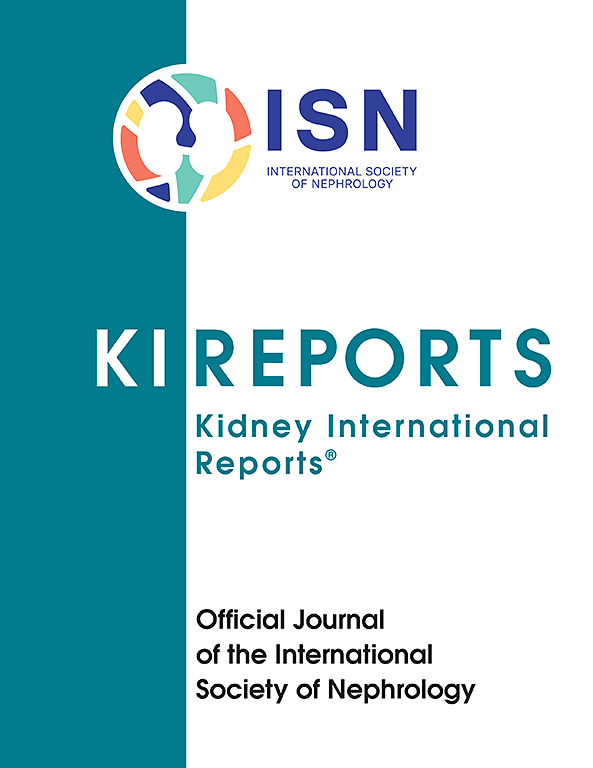Longitudinal Lipid Trajectories and Progression of CKD in Children
IF 5.7
2区 医学
Q1 UROLOGY & NEPHROLOGY
引用次数: 0
Abstract
Introduction
There are discrepant findings regarding the effect of dyslipidemia on disease progression in adult patients with chronic kidney disease (CKD).
Methods
In a prospective cohort study of children with stage 3 to 5 (predialysis) CKD, triglycerides (TGs), total cholesterol (CHOL), low-density lipoprotein cholesterol (LDL-C), and high-density lipoprotein cholesterol (HDL-C) were measured semiannually. We investigated whether CKD progression is associated with serum lipid levels at baseline and with lipid trajectories during follow-up. CKD progression was defined as the time to a composite event of 50% reduction in estimated glomerular filtration rate (eGFR), eGFR < 10 ml/min per 1.73 m2, or start of kidney replacement therapy. By semiparametric group-based trajectory modeling (GBTM), 2 trajectories were defined for each lipid, termed “high” and “low.”
Results
A total of 681 patients aged 12.2 ± 3.3 years with a mean eGFR of 26.9 ± 11.6 ml/min per 1.73 m2 were included. Kidney diagnosis was classified as congenital anomalies of the kidneys and urinary tracts (CAKUT) in 69%, glomerulopathy in 8.4%, and other disorders in 22.6% of patients. During a median of 5.1 years of follow-up, 59% of patients reached the composite end point. Kidney survival was significantly different for HDL-C (P = 0.0128), but not for other lipid trajectories in the Kaplan-Meier analysis. There was no significant association of any of the lipid trajectories with CKD progression in Cox proportional hazard models. Variables consistently associated with CKD progression in models for each lipid at baseline and for lipid trajectories included age, a diagnosis other than CAKUT, eGFR at baseline, albuminuria, the serum albumin level, and diastolic blood pressure (BP).
Conclusions
These data do not support an important role for lipids in the progression of CKD in children.

儿童CKD的纵向脂质轨迹和进展
关于成人慢性肾病(CKD)患者的血脂异常对疾病进展的影响,有不同的发现。方法对3 ~ 5期(透析前)CKD患儿进行前瞻性队列研究,每半年检测一次甘油三酯(TGs)、总胆固醇(CHOL)、低密度脂蛋白胆固醇(LDL-C)和高密度脂蛋白胆固醇(HDL-C)。我们调查了CKD进展是否与基线时的血脂水平和随访期间的血脂轨迹有关。CKD进展被定义为达到估计肾小球滤过率(eGFR)降低50%的复合事件的时间。每1.73 m2 10ml /min,或开始肾脏替代治疗。通过半参数组轨迹建模(GBTM),为每种脂质定义了两条轨迹,分别称为“高”和“低”。结果共纳入681例患者,年龄12.2±3.3岁,平均eGFR为26.9±11.6 ml/min / 1.73 m2。肾脏诊断为肾脏和尿路先天性异常(CAKUT)占69%,肾小球病变占8.4%,其他疾病占22.6%。在平均5.1年的随访期间,59%的患者达到了复合终点。在Kaplan-Meier分析中,HDL-C组的肾脏存活率有显著差异(P = 0.0128),但其他脂质轨迹组无显著差异。在Cox比例风险模型中,任何脂质轨迹与CKD进展均无显著关联。在基线和脂质轨迹模型中,与CKD进展一致相关的变量包括年龄、除CAKUT外的诊断、基线eGFR、蛋白尿、血清白蛋白水平和舒张压(BP)。结论:这些数据不支持脂质在儿童CKD进展中的重要作用。
本文章由计算机程序翻译,如有差异,请以英文原文为准。
求助全文
约1分钟内获得全文
求助全文
来源期刊

Kidney International Reports
Medicine-Nephrology
CiteScore
7.70
自引率
3.30%
发文量
1578
审稿时长
8 weeks
期刊介绍:
Kidney International Reports, an official journal of the International Society of Nephrology, is a peer-reviewed, open access journal devoted to the publication of leading research and developments related to kidney disease. With the primary aim of contributing to improved care of patients with kidney disease, the journal will publish original clinical and select translational articles and educational content related to the pathogenesis, evaluation and management of acute and chronic kidney disease, end stage renal disease (including transplantation), acid-base, fluid and electrolyte disturbances and hypertension. Of particular interest are submissions related to clinical trials, epidemiology, systematic reviews (including meta-analyses) and outcomes research. The journal will also provide a platform for wider dissemination of national and regional guidelines as well as consensus meeting reports.
 求助内容:
求助内容: 应助结果提醒方式:
应助结果提醒方式:


